2014 Yamaha Vector vs. SMART fortwo
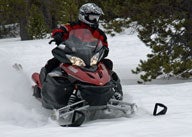
Yamaha Vector technology compares favorably with the SMART car
Aside from the fact that one vehicle has wheels and the other a track, we find similarities between the 2013 SMART fortwo car and Yamaha’s 2014 Vector snowmobile. Our curiosity was piqued when recently we read about how the big automobile manufacturers – including Ford and General Motors – were studying the feasibility of dropping three-cylinder motors into small cars to help them meet the upcoming federally mandated mileage requirements. These engines would mimic modern sled engines in interesting ways.
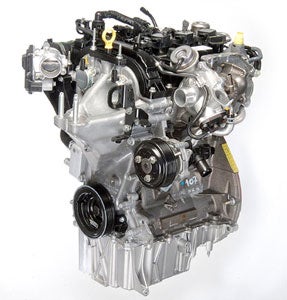 A 1.0-Liter EcoBoost triple is expected to power a version of Ford’s 2014 Fiesta, making it one of the most fuel-efficient non-hybrid cars available in the United States.
A 1.0-Liter EcoBoost triple is expected to power a version of Ford’s 2014 Fiesta, making it one of the most fuel-efficient non-hybrid cars available in the United States.In Ford’s case the upcoming EcoBoost triple should appear in North American versions of its new Fiesta econo-car. General Motors currently is ramping up for production of a three-cylinder engine as a mileage enhancement for various models. Of course, small triples are no big deals to these companies as they have tried mileage-making motors in various versions of their cars sold in the European and Asian markets. But, what really stood out for us on second look was how the Daimler-owned SMART fortwo and Yamaha’s Vector enjoy strikingly similar technologies.
The 2014 Yamaha Vector series enters the upcoming snow season with minimal change. But, when you look at three of its key components – engine, protective shell and steering – you’ll note a similar set in the SMART fortwo. There is also the fact that US pricing is similar as well. The stretch-tracked 2014 Vector LTX carries a manufacturers suggested retail price of US$12,199. The SMART retails at US$12,490 for a base Pure Coupe.
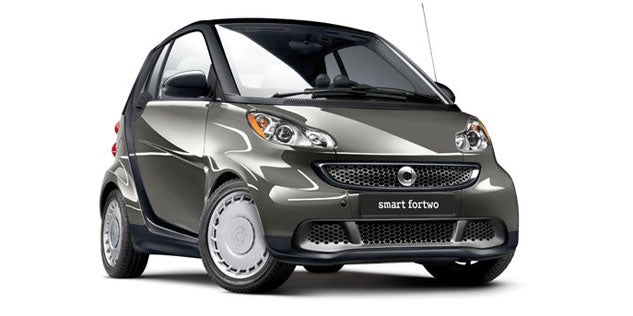 Price-wise, dimensionally and content-wise the SMART car shares some interesting similarities to today’s 2014 Vector snowmobile.
Price-wise, dimensionally and content-wise the SMART car shares some interesting similarities to today’s 2014 Vector snowmobile.Check out the similarities in the engine bay. The Yamaha comes with greater power (125-ish horsepower) and, at 1049cc, enjoys 50cc greater displacement. With only about 70 hp from its 999cc Mitsubishi Motors sourced three-cylinder engine, the SMART has a 50 hp disadvantage. Since the car has wheels and the sled has a track, the SMART has an advantage of lower friction to overcome under acceleration, which we would suggest is leisurely at best. Various published reviews indicate that the SMART gets to 60 miles per hour in about 14 seconds and tops out around 90 mph. You can expect better performance from the Yamaha, which is quite a bit lighter than the 1800-pound curb weight of the SMART. Fuel economy of the SMART is rated at 38 mpg. The Vector does well to stay around 20 mpg.
VIEW: Read our Review of the Yamaha Vector EPS
Engine-wise the Vector takes advantage of its 12-valve mid-performance Yamaha triple with electronic fuel injection and tuned rear-exiting exhaust. The Mitsubishi triple also features 12 valves and electronic computerized intake. But, at 70 horsepower it won’t match the Yamaha.
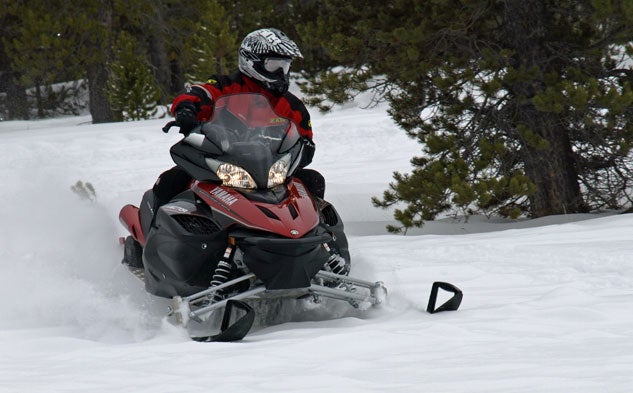 Smoothly reliable, the 2014 Yamaha Vector ease you over many miles of groomed trails thanks to its effort-reducing electric power steering and well balanced ride.
Smoothly reliable, the 2014 Yamaha Vector ease you over many miles of groomed trails thanks to its effort-reducing electric power steering and well balanced ride.Of course, the two vehicles stash their drivetrains in opposite ends. The Vector mounts the Genesis triple up front between the skis. The SMART drops its powertrain in the rear to work the rear wheels.
You’ll find that Yamaha utilizes its in-house technologies in casting a lightweight cocoon for its engine and drive components. This Deltabox II frame not only supplies support for the Vector’s components, including area space for the electric steering gear, it is key to structurally altering the Yamaha design to suit the latest in rider forward positioning. Deltabox II framing is rugged, yet relatively light and uniquely Yamaha as it also can supply a measure of rider protection in a crash. While not as purposely constructed for safety as the SMART fortwo’s crunch-able Tridion frame, the end results of both will help protect the rider.
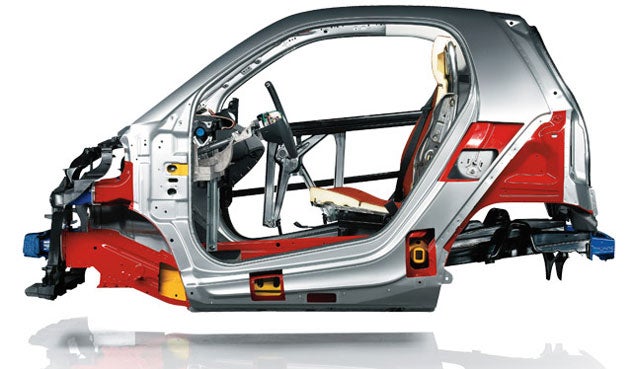 The SMART car features a unique protective cage to protect its occupants, something that Yamaha’s Deltabox II frame emulates.
The SMART car features a unique protective cage to protect its occupants, something that Yamaha’s Deltabox II frame emulates.SMART fortwo’s patented safety cell extends around the perimeter of the driver’s environment with racecar efficiency. The so-called crash management system comprised of high-strength steel is like a giant roll cage that is designed to evenly distribute a crash’s energy while the car’s eight Mercedes-Benz engineered full-sized airbags deploy.
VIEW: Read our feature on OEM Snowmobile Skis
Both the Vector and the SMART fortwo also share electric power steering. Of course, the Vector’s EPS works on turning the new-for-2014 Tuner skis. The SMART’s EPS turns its 15-inch front wheels. Still, the EPS concept is similar to both vehicles as it was specified to offer varying amounts of turning power under different conditions. In low speed applications – slow tight trails for the sled and parking for the car – more assist is available. As speeds increase the assistance backs off. EPS draws electrical power in both instances and doesn’t drain engine resources to reduce performance, which the 70 hp car can ill afford.
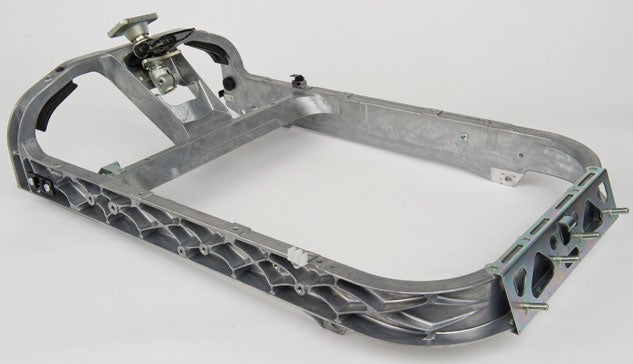 Yamaha’s Deltabox II frame protects the drive components and establishes the sled’s ride-forward designs.
Yamaha’s Deltabox II frame protects the drive components and establishes the sled’s ride-forward designs.The car features a fairly typical McPherson strut styled suspension system with a lower wishbone arm. The Vector continues with upper and lower A-arms controlling nine inches of travel via 40mm aluminum-bodied high pressure gas shocks. The rear suspension of the SMART centers around a solid axle and damping from simple hydraulic shocks. The Vector rear suspension accommodates upward of 11 inches of travel from a parallel rail slide suspension equipped with a stout 46mm compression “clicker” shock.
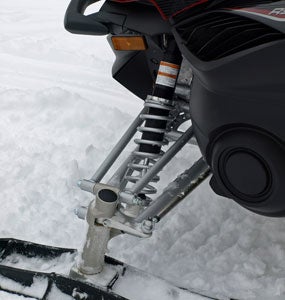 Double wishbone suspension controls nine inches of travel and the new for 2014 Tuner ski.
Double wishbone suspension controls nine inches of travel and the new for 2014 Tuner ski.Braking gets interesting, too. The modern-day Vector utilizes a twin-piston caliper brake design. This disc braking system has proven both efficient and extremely reliable over the years and with its hydraulic assist, modulating braking pressure is consistent and reliable.
On the face of it, we find the SMART car’s braking setup a bit odd. Front “whoa-power” comes from credible 11-inch diameter front disc brakes. The rear system resorts to old-technology eight-inch drum brakes, which need to control more than 50 percent of the vehicle’s 1,800 pounds of mass. Based on our experience with motorcycles, we understand greater front stopping power as up to 60 percent of a bike’s braking can get accounted for there and rear wheel lockup can be a bad, bad thing. But, here, we’d expect a need for enhanced braking power on the heavier weighted rear end. Of course, who are we to question Mercedes-Benz engineering? The car does feature electronic stability control and a traction control system.
When it comes to basic dimensions, the two vehicles again share some similarities. The Vector LTX at 118 inches in overall length stretches out more than a foot beyond the SMART. The sled’s ski stance of 42.8 inches seems narrow compared to the car’s front track width of 50.5 inches. And again there is the price difference of about US$300 in favor of the sled.
VIEW: Read our review of the Ski-Doo MXZ TNT ACE 900
While the SMART fortwo and the Vector share similarities, you aren’t going to buy a car to do what a Vector can do. Still, it is interesting to note that snowmobile technologies and automotive ones bear more in common than we might ordinarily think. The SMART fortwo also shares some commonality with Ski-Doo’s new 900cc, 90 hp triple as well. Both feature programmable electronic modes for enhanced mileage or performance. Is that a case of sleds keeping up with cars, or vice versa?
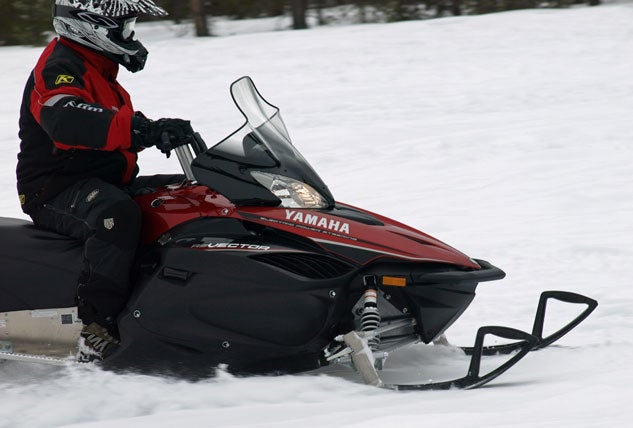 Minimally changed for the upcoming season, the Vector does get the latest Yamaha skis, which can be tuned to your specific ride-style.
Minimally changed for the upcoming season, the Vector does get the latest Yamaha skis, which can be tuned to your specific ride-style. With the drivetrain similarities coming closer together, perhaps we’ll see more synergy between cars and sleds in the near future. Snowmobiles have turbocharged one-liter engines and that seems to be the coming thing for automobiles of the future. Then again, cars, SAABs specifically, once came standard with 850cc three-cylinder two-strokes. How’s that working for us now?




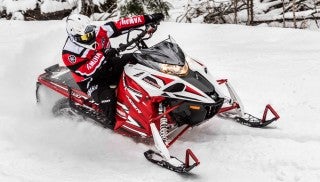



 Your Privacy Choices
Your Privacy Choices